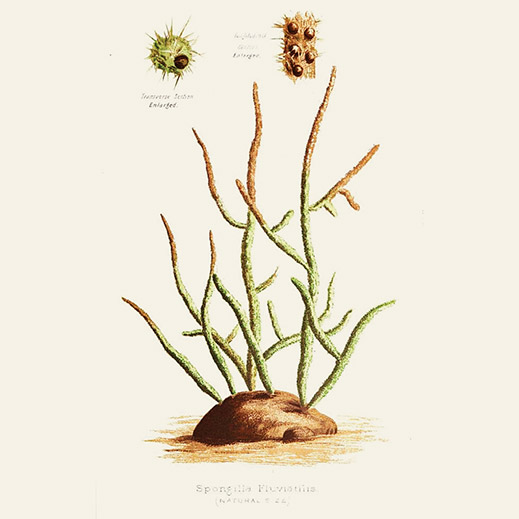More than a century before the song “Dirty Water” debuted in the 1960s, Bostonians were lodging a peculiar complaint: their tap water tasted like cucumbers.

Engineers had begun transporting water into the city through wooden pipes in 1795. By the late 1800s, iron pipes were bringing in millions of gallons each day from such sources as the Sudbury River, a gentle tributary of the Concord River.
An odd taste was noted as early as the 1850s and reappeared in 1875. The cause wasn’t immediately clear. Worried that the water had been accidentally contaminated, city officials asked William Ripley Nichols, Class of 1869, to investigate.
In the world of New England water, Nichols was a major player. An MIT grad and a professor of chemistry at the Institute, he was the Massachusetts Board of Health’s go-to researcher for all kinds of sanitation queries. For more than a decade, Nichols had analyzed local ponds and explored troubled pipes. Once, he’d been dispatched to check out a reservoir full of diseased fish.
That fall, Nichols got to work. He visited suspect sources to sample the water and consulted other experts, including Harvard botanist W. G. Farlow. Despite careful testing, Nichols could not determine what was behind the cucumber taste. In his 1876 Report on a Peculiar Condition of the Water Supplied to the City of Boston, he ran through the prevailing theories, including decaying animal or vegetable matter. Still, he wrote, “I must frankly confess that as yet I am quite in the dark as to the cause of the trouble.”
In the fall of 1881, the taste grew so bad that many Bostonians resorted to buying spring water from carts. Official reports sometimes characterized the tap water as “oily” or “fishy” in addition to cucumber-like. The Tech, then in its first year of publication, politely called it “peculiar.” One scientist put it more bluntly: “The water tastes of the pig-pen.”
By then, Nichols had fallen ill with pleurisy, so a new scientist took over the investigation: Johns Hopkins chemist Ira Remsen, who had recently stumbled on saccharin, the first artificial sweetener. When he arrived in Boston, he set about obtaining his own samples. He discovered that some—particularly those from Farm Pond, a natural basin connected to the Sudbury River—were chock-full of albuminoid ammonia, a marker for contamination with organic material. He tried those samples and found they tasted far worse than those that were ammonia-free.
As his report to the city delicately put it, “The chemical evidence is in accordance with that obtained of the senses.”
Remsen trooped back to the troubled water sources and ultimately nabbed the culprit: a freshwater sponge known as Spongilla fluviatilis. It had settled in leafy green clumps all along the banks and the bottom of Farm Pond. There, it was decomposing—rotting right into the water supply. “The marked intensity of the odor … was stronger than I had ever before perceived,” wrote Farlow, who was consulted again on the new findings.
That November, Remsen recommended that the city lower the level of Farm Pond to remove clumps of the decaying sponge. But he noted that it would be impossible to drain the pond completely, as the Sudbury River flowed directly through it. City workers would have to remain vigilant, rooting out any sponges that might spring up along the water’s route to the city.
Indeed, after the city lowered Farm Pond and built a temporary, mile-long ditch to allow Sudbury water to flow directly to the aqueduct, workers collected “nearly a bushel-basketful” of the sponges from every square yard of the old conduit.
The work appeared to be successful. By January 1882, a doctor reported to the Boston Medical and Surgical Journal that while the water still retained some of its smell, he could once again drink “without disgust.” The next year’s annual report of the Boston Water Board confirmed that the off taste had abated. But to prevent it from returning, an 1883 report recommended constructing a permanent conduit around or across the pond and cleaning both the new conduit and the aqueduct to Boston every year.
The scientists who pinpointed the problem got little public recognition for their efforts. “Few men would choose to follow sanitary chemistry exclusively if they were ambitious of a wide reputation as chemists,” Nichols once said at a meeting of the American Association for the Advancement of Science. “The consciousness of work well done brings satisfaction if it does not bring glory.”
Keep Reading
Most Popular
Large language models can do jaw-dropping things. But nobody knows exactly why.
And that's a problem. Figuring it out is one of the biggest scientific puzzles of our time and a crucial step towards controlling more powerful future models.
How scientists traced a mysterious covid case back to six toilets
When wastewater surveillance turns into a hunt for a single infected individual, the ethics get tricky.
The problem with plug-in hybrids? Their drivers.
Plug-in hybrids are often sold as a transition to EVs, but new data from Europe shows we’re still underestimating the emissions they produce.
Stay connected
Get the latest updates from
MIT Technology Review
Discover special offers, top stories, upcoming events, and more.